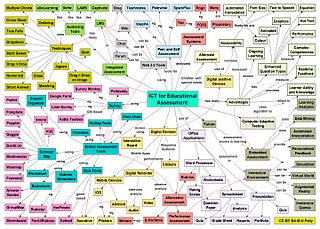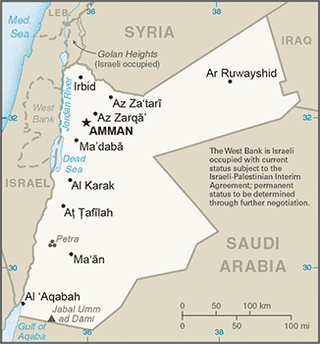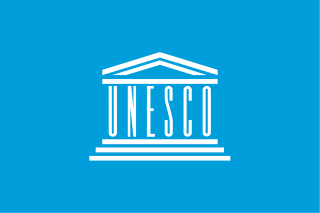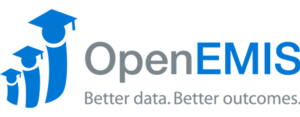
Information and communications technology (ICT) is an extensional term for information technology (IT) that stresses the role of unified communications and the integration of telecommunications and computers, as well as necessary enterprise software, middleware, storage and audiovisual, that enable users to access, store, transmit, understand and manipulate information.

Open educational resources (OER) are teaching, learning, and research materials intentionally created and licensed to be free for the end user to own, share, and in most cases, modify. The term "OER" describes publicly accessible materials and resources for any user to use, re-mix, improve, and redistribute under some licenses. These are designed to reduce accessibility barriers by implementing best practices in teaching and to be adapted for local unique contexts.
Education in Colombia includes nursery school, elementary school, high school, technical instruction and university education.
Agricultural Information Management Standards (AIMS) is a web site managed by the Food and Agriculture Organization of the United Nations (FAO) for accessing and discussing agricultural information management standards, tools and methodologies connecting information workers worldwide to build a global community of practice. Information management standards, tools and good practices can be found on AIMS:
Education in the State of Palestine refers to the educational system in the Gaza Strip and the West Bank, which is administered by the Palestinian Ministry of Education and Higher Education. Enrollment rates amongst Palestinians are relatively high by regional and global standards. According to a youth survey in 2003, 60% between the ages 10–24 indicated that education was their first priority. Youth literacy rate is 98.2%, while the national literacy rate is 91.1%. Enrollment ratios for higher education were 45% in 2022. In 2016 Hanan Al Hroub was awarded the Varkey Foundation Global Teacher Prize for her work in teaching children how to cope with violence.

The education system of the Hashemite Kingdom of Jordan includes basic, secondary, and higher education and has dramatically evolved since the establishment of the state in the early 1900s. The role played by a good education system has been significant in the development of Jordan from a predominantly agrarian to an industrialized nation over time.

The International Programme for the Development of Communication is a United Nations Educational, Scientific and Cultural Organization (UNESCO) programme aimed at strengthening the development of mass media in developing countries.

Education in Azerbaijan is regulated by the Ministry of Education of Azerbaijan.
Education in Belize is governed by the Education Act.
Education in Barbados is based primarily on the British model.

The United Nations Educational, Scientific and Cultural Organization (UNESCO) is a specialized agency of the United Nations (UN) with the aim of promoting world peace and security through international cooperation in education, arts, sciences and culture. It has 194 member states and 12 associate members, as well as partners in the non-governmental, intergovernmental and private sector. Headquartered in Paris, France, UNESCO has 53 regional field offices and 199 national commissions.

The Ministry of Education (MoE) is a ministry of the Government of India, responsible for the implementation of the National Policy on Education. The ministry is further divided into two departments: the Department of School Education and Literacy, which deals with primary, secondary and higher secondary education, adult education and literacy, and the Department of Higher Education, which deals with university level education, technical education, scholarships, etc.
The International Institute for Educational Planning is an arm of UNESCO created in 1963 in Paris, France. It develops the capacities of education actors to plan and manage their education systems through its programmes of training, technical assistance, policy research and knowledge sharing.

The Ministry of Science and Education of the Republic of Azerbaijan is a governmental agency within the Cabinet of Azerbaijan in charge of regulating the education system in Azerbaijan.

National Institute of Educational Planning and Administration is a research focused university located in New Delhi, India. The institute was set up by the Ministry of Human Resource Development, Government of India.
Synergy International Systems, Inc. is an information technology and consulting company based in Washington, D.C. that provides web-based software to international development agencies, country governments, NGOs and private sector partners. Their key products are focused on monitoring and evaluation (M&E), national development effectiveness, aid management, judicial system modernization, social protection, public financial management, disaster relief and reconstruction, environment, education, and public health. There is a company-maintained global learning center in Yerevan, Armenia. The company's services include software development and customization, IT strategy consulting, systems integration, capacity development and technical support. Synergy has developed management information systems for public and private sector clients in 65 countries.
The National Garifuna Council (NGC) of Belize is a non-governmental organization that represents the Garifuna people of Belize. Their mission is to preserve, strengthen, and develop the Garifuna culture, as well as to promote economic development, interracial harmony among the Garifuna people, and maintain traditional respect for preserving the environment. It was established in 1981 and is managed by a board of directors with corresponding branches in Guatemala, Honduras, and Nicaragua. These countries all share the unique Garifuna culture, as they all served as refuge to the Garifuna people when they were exiled from their homeland, St. Vincent.
Information Communications Technology is usually included in the Home Economics and Livelihood Education program in grade school and taught through the Technology and Home Economics program in high school. The recent status of ICT education in the Philippines, along with other Southeast Asian countries, was surveyed by the Southeast Asian Ministers of Education Organization (SEAMEO) in 2011. Using the UNESCO model of ICT Development in Education, the countries were ranked as Emerging, Applying, Infusing or Transforming. The Philippines were ranked at the Infusing stage of integrating ICT in education, indicating that the country has integrated ICT into existing teaching, learning and administrative practices and policies. This includes components such as a national vision of ICT in education, national ICT plans and policies, complementary national ICT and education policies, professional development for teachers and school leaders, community or partnership and teaching and learning pedagogies. A 2012 study reported that public high schools in Metro Manila had a computer to student ratio of 1:63. While 88 percent of schools have internet connections, half of the students claimed not to be using it.
Open educational resources in Canada are the various initiatives related to open education, open educational resources (OER), open pedagogies (OEP), open educational practices (OEP), and open scholarship that are established nationally and provincially across Canadian K-12 and higher education sectors, and where Canadian based inititatives extend to international collaborations.
Educational technology in sub-Saharan Africa refers to the promotion, development and use of information and communication technologies (ICT), m-learning, media, and other technological tools to improve aspects of education in sub-Saharan Africa. Since the 1960s, various information and communication technologies have aroused strong interest in sub-Saharan Africa as a way of increasing access to education, and enhancing its quality and fairness.











